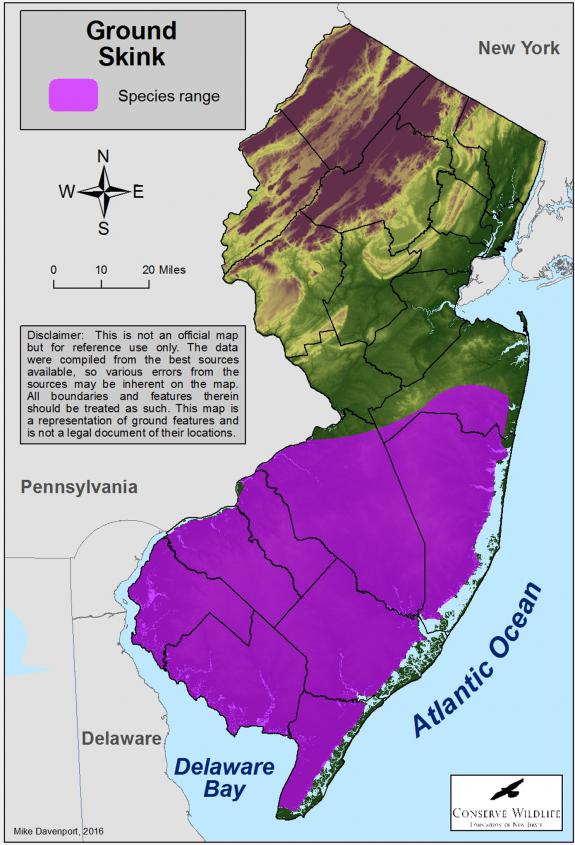Scincella lateralis
Type: reptile
Status: special concern
Species Guide
Little brown skink
Scincella lateralis
Species Type: reptile
Conservation Status: special concern
IDENTIFICATION
The little brown skink (Scincella lateralis), formally known as the ground skink, is an elusive member of the lizard family. This is a small skink, slender and short of leg, measuring between 3 – 5½ inches. It can range in color from tan to almost black, yet most are a coppery color with dark lateral stripes on either side of the body. The underside is a creamy color, slightly lighter under the chin and at the waist. Females tend to be slightly larger than males, and some head-shape dimorphism may exist. Otherwise, both genders display the same color patterns. Like other lizards in the family Scincidae, the little brown skink possess a transparent window in a movable lower eyelid.

Distribution & Habitat
The little brown skink is widely dispersed in the United States, its range spanning from New Jersey to Florida, west to Kansas, Texas, north to southern Illinois, southern Indiana and southern Ohio, and south to the Gulf Coast. Within New Jersey, the ground skink can be found in the southern half of the state.
Found in many different habitats, the ground skink typically prefers areas with loose soil and ground cover. True to its name, the ground skink virtually never climbs. This is unlike other forest-dwelling skinks. Rather than running on their small legs, it quickly slithers through plant debris and soil. It can often be found taking shelter under leaf litter and logs, disappearing quickly when discovered. During cold weather, the ground skink will burrow underground.
Diet
A predator of invertebrates such as insects and spiders, the ground skink searches for its prey as it “swims” through the ground debris. Both adults and young individuals are invertivores.
Life Cycle
This is a short-lived species, most surviving up to two years and very rarely up to four. Courtship and mating occur in the spring and summer months. Females typically lay two clutches in a season. Clutch size is small, between 1 and 9 eggs. Eggs are retained within the female for some time, resulting in partially developed embryos when the eggs are laid and thus a short incubation time. Females choose to oviposit their eggs in decaying wood material and do not guard their eggs like some other species of lizard. This is a diurnal species, active between March and October, hibernating/aestivating during the winter months.
Current Threats, Status, and Conservation
In 2016, the New Jersey Endangered and Nongame Advisory Committee recommended a Special Concern status for this species within the state, but no formal rule proposal was adopted until January 2025. Loss of ground skink habitat threatens the survival of this species. Any activities that reduce canopy or understory cover, leaf litter and other forest floor debris reduce ground skink habitat and therefore its ability to survive.
In January 2025, the NJDEP adopted a rule proposal changing the status of the little brown skink to special concern.
HOW TO HELP
The Endangered and Nongame Species Program would like for individuals to report their sightings of ground skinks. Record the date, time, location, and condition of the animal and submit the information by submitting a Sighting Report Form. The information will be entered into the state’s natural heritage program, commonly referred to as Biotics. Biologists map the sighting and the resulting maps “allow state, county, municipal, and private agencies to identify important wildlife habitats and protect them in a variety of ways. This information is used to regulate land-use within the state and assists in preserving endangered and threatened species habitat remaining in New Jersey.”
References
- NJ Fish and Wildlife
- IUCN Red List
- VA Department of Game and Inland Fisheries
- Savannah River Ecology Laboratory
Text written by Kendall Miller in 2016.
Scientific Classification
- Kingdom: Animalia
- Phylum: Chordata
- Class: Reptilia
- Order: Squamata
- Family: Scincidae
- Genus: Scincella
- Species: S. lateralis